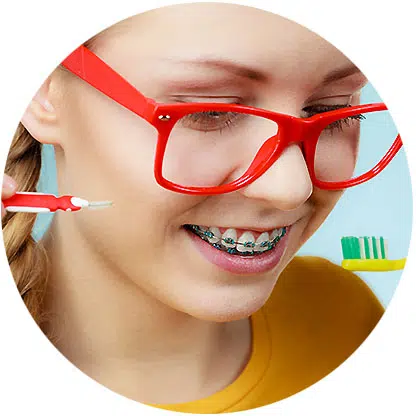
Types of Braces
In the past, braces included large metal bands that were enclosed and attached around each tooth. Today, tiny brackets are placed onto the front surface of the tooth and are made of metal (silver) or ceramic (clear).
The brackets are bonded to the tooth surface with a glue-like material and sometimes metal bands are used on the back teeth. Arch wires are placed inside the brackets and are made of a heat-activated nickel-titanium source that can become warm due to the temperature in the mouth, which allows it to apply constant pressure on the teeth as well as when the arch wires are adjusted at the orthodontic office.

How to properly clean your braces
Your orthodontist, along with their dental assistants will provide you with thorough instructions of how to properly clean your braces. There are many types of toothbrushes; power, manual or sonic to use that is specifically designed for orthodontic patients. Brushing should be conducted 3-4 times a day to remove plaque and maintain good oral health.
It is very important to clean in between your teeth with dental floss to remove food debris. Oral irrigators may also be recommended to remove food debris and irrigate the gum tissue to remove odor-causing bacteria.

What to eat when you have braces
Your mouth will be sensitive the first day or two after having braces placed, we recommend eating softer foods during this time. Chewing will help to reduce the level of discomfort; however, eat food that has a softer texture.
Yes-yes foods with Braces
- Mashed potatoes
- Smoothies
- Yogurt
- Soup
- Pasta and Rice
- Soft fruit
- Pudding and Jell-O
- Soft sandwiches like Peanut butter & Jelly
- Soft or cooked vegetables
- Apple slices
- Olives (with no pits) and Pickles
While you are in braces it is important to avoid sticky and hard foods. These kinds of foods can break or bend wires, break off brackets, or loosen bands. Foods high in sugar should also be avoided or kept to a minimum to reduce the risk of tooth decay and gum disease.
No-no foods with Braces
- Beef jerky
- Corn on the Cob
- Popcorn
- Raw veggies and whole apples
- Hard candies and suckers
- Pop and Energy drinks
- Ribs and Chicken wings
- Nuts
- Hard chips
- Tootsie Rolls
- Licorice
- Snickers
- Skittles


